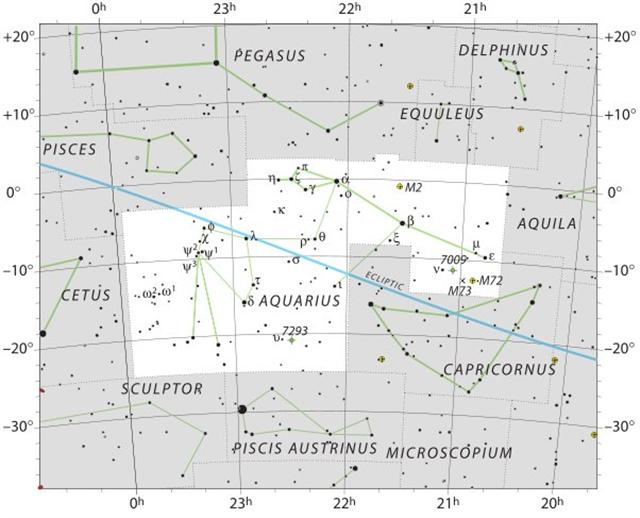1. Let's return to the great Aquarius constellation. We should list the numerous (15) stars in its central 23rd hour and begin with ο. The Chinese name for this star is Kae Uh, Roof, which is in harmony with the position close to α Aquarii (Rooftop):

Only the 7th star, π, is above the 'surface of the sea' (and has always been so irrespective of the precession):
According to the Chinese view π would have been above the 'top of the roof', though this Rooftop is not the horizontal 0º line, it is rather oriented with the roof towards the west: "The present-day Alpha Aquarii was joined with Theta and Epsilon Pegasi to form a V-shape, like the pitched roof of a building, called Wēi, 'rooftop'. There are in fact three Chinese constellations whose names are Romanized as Wei, and each has a different meaning. This Wēi is the one after which the 12th lunar mansion is named. (The other two are in Aries and Scorpius.)" (Ian Ridpath's site) The idea of a rooftop reminds me of the top of the head of Ku (cfr at The Queen of Hearts): ... the breadfruit originated from the sacrifice of the war god Ku. After deciding to live secretly among mortals as a farmer, Ku married and had children. He and his family lived happily until a famine seized their island. When he could no longer bear to watch his children suffer, Ku told his wife that he could deliver them from starvation, but to do so he would have to leave them. Reluctantly, she agreed, and at her word, Ku descended into the ground right where he had stood until only the top of his head was visible. His family waited around the spot he had last been, day and night watering it with their tears until suddenly a small green shoot appeared where Ku had stood. Quickly, the shoot grew into a tall and leafy tree that was laden with heavy breadfruits that Ku's family and neighbours gratefully ate, joyfully saved from starvation ... Via Wikipeida I found an interesting site, The International Dunhuang Project, which offers this picture:
I due time we will surely familiarize ourselves with the Chinese sky, and then also discover the precise location of the Roof (Kae Uh) and its top (Sadalmelik). For the moment it is enough to learn about the 5 animal figures: The Black Tortoise, Xuan wu (玄武), represents both north and the winter; A symbol of longevity, the tortoise of the north is often depicted together with a snake. The union of these two creatures was thought to have created the earth. It is also associated with the element water. The Blue Dragon, Qing long (青龙), represents both east and the spring; Unlike in western mythology, the dragon is rarely depicted as a malevolent force but generally considered to be both benevolent and auspicious. It is also often associated with the emperor and therefore linked to the Red Bird, whose own association is with the empress. The dragon is associated with the element wood. The Red Bird, Zhu que, (朱雀) represents the south and the summer; The bird is sometimes seen as a phoenix and associated with good fortune. It is also often paired with the dragon. It is associated with the element fire. The White Tiger, Bai hu, (白虎) represents the west and the autumn; The tiger is often seen as a protector and was thought to guard over the armies of the emperor and protect the spirits of the dead. It is associated with the element metal. | ||||||||||||||||||||||||||||||||||||||||||||||||||||||||||||||||||||||||||||||||||||||||||||||||||||||||||||||||||||||||||||||||||||||||||||||||||||||||||||||||||||||||||||||||||||||||||||||||||
